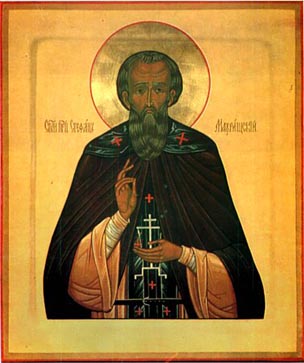
The Monk Stefan of Makhrisch
Commemorated on July 14
The Monk Stefan of
Makhrisch was a native of Kiev. He accepted monasticism at the Pechersk
monastery, where he spent several years in deeds of obedience and prayer. The
oppressions by the Papists compelled him to journey on to Moscow, where
GreatPrince Ivan II (1353-1359) graciously received him, permitting him to
settle in the locale of Makhrisch not far from Gorodisch, 35 versts from the
Sergeev wilderness-monastery.
Having built himself
a cell and spending his life at ascetic labours, and esteeming silence, he did
not accept those wishing to join him. But then he yielded to the requests, and
by such manner, in 1358 he founded a monastery, in which he was established as
hegumen.
Living near his
monastery were the Yurkov brothers, fearing that the land which they ruled
might be given over to the monastery, and they threatened to kill the holy
ascetic. The admonitions of the monk did not help. Saint Stefan then moved to a
different place. Sixty versts north of Vologda, at the River Avnezha, he
founded with his disciple Grigory a wilderness-monastery in the Name of the
Holy Trinity. GreatPrince Dimitrii Ioannovich sent books and other liturgical
items to the Avnezhsk wilderness, but the Monk Stefan sent them in turn to the
Makhrisch monastery. Having returned to his monastery, Saint Stefan ordered
life in it according to a "life in common" ustav (rule).

When the Monk Sergei
of radonezh moved form his monastery, in order to find a place for his ascetic
deeds, the Monk Stefan then received him, and gave the great ascetic Sergei his
own disciple Simon, who knew the surrounding area quite well. The Monk Sergei
settled together with Simon on the island of Kirzhach, where he founded a
monastery.
Saint Stefan was
strict with himself and indulgent towards others, he it was that worked for the
monastery the hardest of all, he zealously guided the brethren to the ways of
salvation with gentle and quiet talks, and he wore clothing very old and
coarse.
The monk lived to
extreme old age, became a schema-monk and died in 1406 on 14 July. In 1550
during the construction of a new stone church in the Name of the Holy Trinity,
his holy remains were uncovered undecayed. They were glorified by blessings of
help in various sicknesses and misfortunes for all calling on the name of the
saint.
© 1996-2001 by translator Fr. S. Janos.